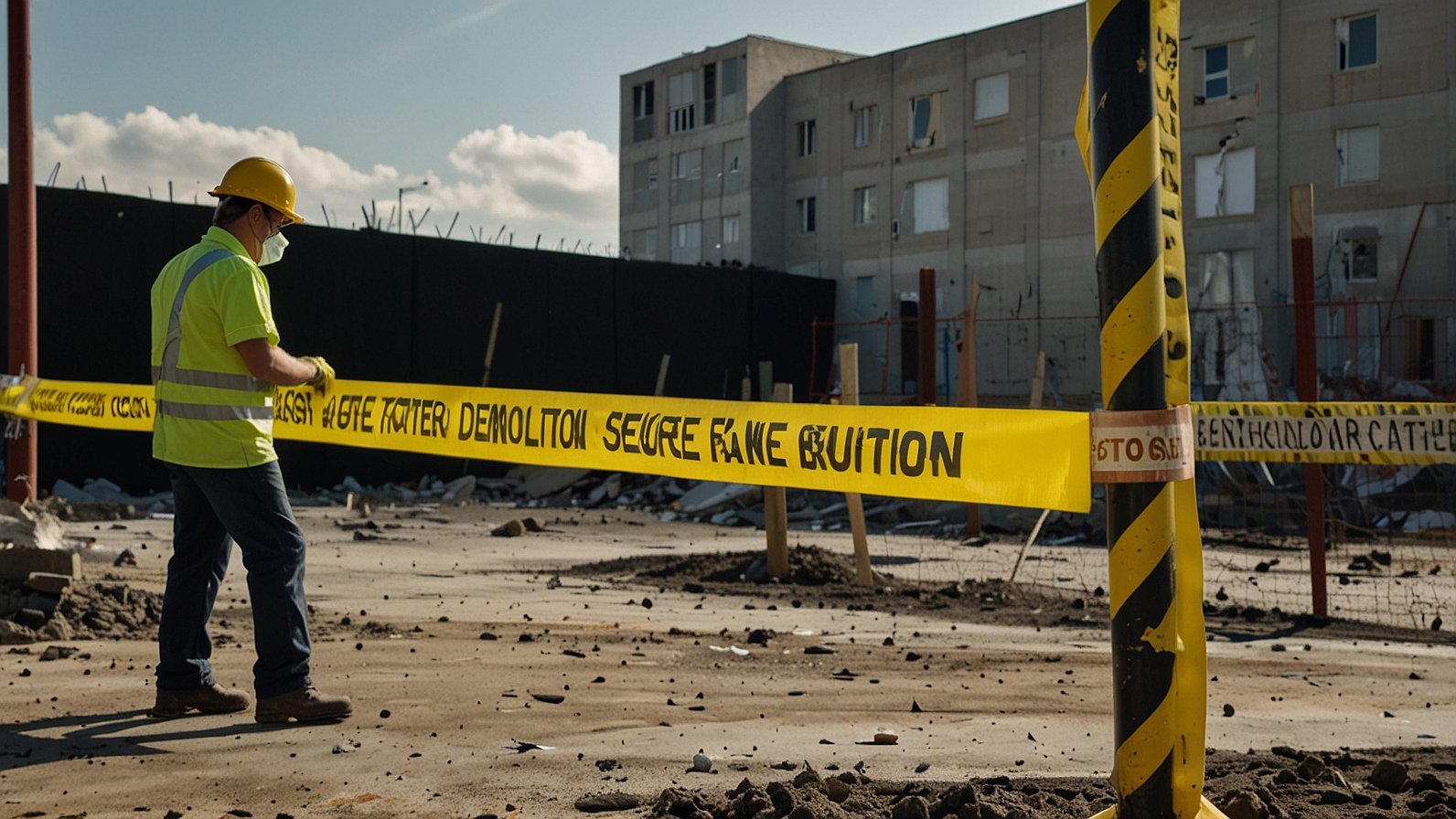Picture this: you’re walking past a renovation site in Amsterdam or Rotterdam, and your eyes catch a stark, bright yellow tape with bold black lettering: “ASBEST — GEEN TOEGANG.” It’s an unmistakable warning, a visual shout that commands attention and respect. That tape, known as asbestlint, is far more than just plastic; it’s the first and most crucial line of defense in managing one of the most notorious health hazards in the built environment.
It’s the silent guardian on a construction fence, the temporary sentry around a skip, and a non-negotiable part of any certified contractor’s toolkit. But what’s the real story behind this high-visibility barrier? Let’s pull back the curtain.
What Exactly is Asbestlint? Your First Visual Warning
Think of asbestlint as the traffic light for hazardous zones. Just as a red light means “stop,” this specific tape universally means “danger—do not cross.” Its design is no accident. The high-visibility yellow and black combination is scientifically proven to be seen from a distance, cutting through visual clutter.
You’ll typically find it imprinted with clear, uncompromising warnings like:
- ASBEST
- GEEN TOEGANG (No Entry)
- LEVENSGEVAAR (Mortal Danger)
- AANGEPASTE ARBO-VOORSCHRIFTEN (Adapted Health and Safety Regulations)
This isn’t generic barrier tape; it’s a specialized communication tool. Its sole purpose is to instantly communicate the presence of asbestos and create a psychological and physical boundary. When you see an asbestlint, you know that certified professionals are managing a serious risk behind that line.
The Critical Role of Asbestlint in Safety and Site Control
So, why is this tape so indispensable? It all boils down to control. Asbestos fibres, when airborne, are a silent threat. You can’t see them, but inhaling them can lead to severe lung diseases decades later. The asbestlint makes the invisible, visible.
Its placement is a formal step in a much larger safety dance, governed by strict Dutch rules. It’s used to:
- Cordon Off Contaminated Zones: Sealing the immediate area where asbestos-containing materials (ACMs) were found or disturbed.
- Mark Temporary Storage: Identifying sealed containers or bags where asbestos waste is held before proper disposal.
- Define Exclusion Zones: Keeping unauthorized personnel, including other trades and the public, safely away from the hazard.
- Signal Compliance: Demonstrating that the contractor is following the legally required asbestverwijderingsprocedures (asbestos removal procedures).
A site using asbestlint correctly is a site that takes its legal and moral responsibilities seriously. It’s a clear sign to safety inspectors and the public that the risks are being managed.
Beyond the Tape: The Rigorous World of Asbestos Removal
Here’s a crucial point many miss: the tape is just the beginning. Seeing an asbestlint should reassure you that a complex, regulated process is unfolding behind the scenes. The tape is the cover of the book; what’s inside is a story of extreme caution.
Actual asbestos removal is not a DIY job. It must be handled by gedecerdeerde asbestverwijderaars (certified asbestos removal companies). The process is meticulous:
- Strict Licensing: Only certified firms can remove most types of asbestos materials.
- Containment: The work area is often sealed with plastic sheeting to create a negative air pressure environment, preventing fibres from escaping.
- Personal Protective Equipment (PPE): Workers wear full-body suits and specialized respirators.
- Controlled Removal & Wetting: Materials are carefully wetted down to suppress dust and carefully removed.
- Safe Disposal: Waste is double-bagged in labelled, heavy-duty bags and taken to designated hazardous waste facilities.
The asbestlint is the public-facing part of this entire, rigorous system.
Myth vs. Fact: Clearing the Air on Asbestlint
Let’s tackle some common misunderstandings head-on.
Myth: “If I see the tape, there are definitely asbestos fibres in the air right now.”
Fact: Not necessarily. The tape marks a potential or confirmed hazard zone. Proper removal under containment drastically reduces the risk of fibres escaping. The tape is a precautionary boundary.
Myth: “Any yellow-and-black tape means the same thing as asbestlint.”
Fact: Absolutely not! While the colours are universal for caution, an asbestlint has specific wording. Generic “CAUTION” tape might be used for simple trip hazards or wet floors. Always look for the word “ASBEST.”
Myth: “Once the tape is down, the job is almost done.”
Fact: The tape often goes up at the very start of the process and remains until the area has been professionally cleaned and air monitoring (if required) confirms it is safe.
Real-World Scenarios: Where You’ll Encounter Asbestlint
This isn’t just theoretical. Companies and municipalities rely on it daily. For instance, when the city of Utrecht managed the renovation of an older school building, the first step after identifying asbestos in the pipe insulation was to wrap the entire section in a bright asbestlint. This immediately alerted school staff and cleaning crews to avoid the area, long before the certified removal team even arrived on site. It’s a simple, cost-effective measure that prevents accidental exposure and demonstrates due diligence.
Your 3-Step Action Plan When You See Asbestlint
- STOP AND RESPECT THE BOUNDARY. Do not cross the line or duck under the tape. No photo, shortcut, or curiosity is worth the risk.
- KEEP YOUR DISTANCE. Give the area a wide berth. If the tape is blocking a path you need, find an alternative route or contact the site manager from a safe distance.
- INFORM OTHERS. If you see someone unaware of the danger, especially children, calmly inform them of the hazard and guide them away.
Wrapping Up: More Than Just Tape
The humble asbestlint is a powerful symbol of modern safety culture. It’s a simple tool that performs a complex job: communicating danger, enforcing boundaries, and upholding a standard of care that protects public health. The next time you see that bright yellow and black tape, you’ll see the quiet confidence of a system designed to keep everyone safe.
What’s the most unexpected place you’ve seen safety protocols like this in action?
You May Also Read: Konversky: The Ultimate Guide to Smarter Customer Conversations
FAQs
Can I buy and use asbestlint myself for a home project?
Yes, you can purchase it, but using it to cordon off a DIY asbestos removal is highly dangerous and illegal for most types of asbestos. The tape is a warning tool, not a license to remove asbestos yourself. Always hire a certified professional.
What’s the difference between asbestlint and other safety tapes?
The key difference is the printed text. Asbestlint specifically mentions “Asbest,” making the hazard clear. Other tapes might say “Caution,” “Danger,” or “Police Line,” which refer to different types of risks or authorities.
Are there specific rules for how asbestlint must be placed?
Yes. Regulations often specify that it must be placed at a safe distance from the actual hazard, be clearly visible from all approaches, and be sturdy enough not to fall down easily. It should form a continuous barrier.
What should I do if I see damaged or fallen asbestlint?
Do not try to fix it yourself. Keep your distance and immediately inform the property owner or the construction company responsible for the site.
Is the color always yellow and black?
In the Netherlands, yellow/black is the standard and expected color scheme for this specific hazard, ensuring instant recognition. Using other colors would defeat its purpose.
How is asbestlint disposed of?
If it has been used to cordon off a contaminated area, it is considered asbestos waste itself. It must be wetted down, carefully removed, and disposed of with other asbestos materials in sealed, labelled containers by the certified removal team.










